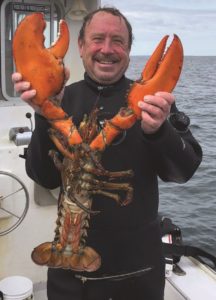PROVINCETOWN — Mike Packard’s experience inside a humpback whale last week is the story that had everything: charismatic heroes, an adventurous setting, an enormous animal co-lead, a happy ending — and, most important, humanity’s eternal, evolution-rigged fear of being eaten alive.
Nearly every American media outlet carried the story: Packard was swallowed by a humpback whale while scuba diving for lobster. Or wait, hold on, not swallowed, definitely not “swallowed” — gallons of ink were spilled on the inaptness of that word to this case. Rather, Packard was engulfed by the open mouth of a young humpback whale, who held him there for about 30 seconds before spitting him out again, dive suit and all.

The amount of time is an estimate, of course, but enough seconds ticked by for Packard to realize that his legs were pinned but not shredded, to understand he’d been scooped up by an animal that wasn’t a shark, to know he was inside a whale, and to consider there wasn’t much he could do about it, and he might well die there.
Fortunately, by that point, the animal had also realized something. The whale swam to the surface, shook Packard loose in full sight of his boatmate Josiah Mayo and nearby charter fisherman Joe Francis, and fled the scene. Mayo and Francis hauled Packard aboard, radioed the rescue squad, and unloaded him at MacMillan Pier with what they thought might be broken legs.
(Happily, it turned out he had a painful sprained knee and some serious bruising of the upper legs, but no broken bones.)
This story has been told on television, radio, and late-night shows. It’s been in newspapers worldwide, and even on the cover of the New York Post (headline: “I Was Nearly Krilled!”). The attention of the press has been overwhelming, according to Mayo; on Monday, the boatmates were in contact with both Jimmy Kimmel and Anderson Cooper about interviews.
Nonetheless, Mayo spoke with the Independent and provided more details about the engulfment.
“Honestly, we’re all lucky this happened to someone like Michael,” said Mayo. “If this was just some yahoo in a kayak, we would still be arguing about whether any of this really happened. There are the eyewitnesses,” he added, but mainly, he said, Packard’s personality and reputation make the difference: “Mike’s character speaks for itself.”
Diving for lobsters can be hazardous even without whales around. It’s been almost exactly 10 years since Sean Strakele died underwater while lobster diving in Herring Cove. It was Packard who found Strakele’s body two days later, only about 100 yards from where he’d descended.
Packard has seen great white sharks out there, as well. In 2017, he told the Provincetown Banner about an ordinary descent near a school of striped bass that turned into a swift retreat when the shark appeared.
On a normal day, though, “we head out around 5:30 or 6 a.m., and we’re only out until 11 or noon,” said Mayo. Lobsters congregate along a steep underwater dropoff, where a shelf that’s around 30 to 50 feet below sea level plunges into deeper waters. “Mike will dive along that edge, looking for lobsters that are large enough and don’t have eggs, and basically grabbing them and stuffing them into the dive bag,” Mayo explained. Packard can bring up 100 pounds of lobster in a single dive, said Mayo, and one trip can include three to eight dives.
Because New England’s waters are so rich in plankton, visibility underwater is only about 15 feet even in good weather, Mayo said. That means neither the whale nor Packard had time to see each other when the whale charged forward.
“When a humpback moves to lunge, its mouth is open hugely, and its eyes, they bulge out a little bit, but they’re off to the sides,” said Jooke Robbins, director of the humpback whale program at Provincetown’s Center for Coastal Studies. “It’s quite likely that it can’t see right in front of its face when it’s feeding like that.
“Based on our work with whale disentanglement, it’s quite clear that, when they’re feeding, they’re getting things in their mouth they didn’t want. Usually, it’s fishing gear,” said Robbins. This time, it was Mike.
Encounters of this kind are extremely rare, said Robbins. Even more rare is that the human wasn’t specifically looking for whales. The closest analogue Robbins could think of was an episode off the coast of South Africa in 2019, when a Bryde’s whale wound up with a man in his mouth: legs out, torso in. But the diver in that case, Rainer Schimpf, was specifically there to photograph a sardine-fueled feeding frenzy, before he briefly became a part of it.
(Schimpf came out of that encounter even less injured than Packard. After being briefly squeezed about the waist and then released from the whale’s jaws, Schimpf boarded the boat, checked his body and his camera, and got back in the water to take more pictures, according to a report in The Guardian.)
There remains one intriguing question, though: whatever happened to the whale?
Robbins was circumspect. “We don’t have an I.D. yet,” she said. “There was a young, small humpback in the area that day, and the previous day, but that whale had also been seen some other places, and I don’t think we can make the assumption that it’s the same whale.
“There was a sighting from a whale watch boat later in the day. It was seen and photographed, but it wasn’t contemporaneous,” Robbins added. “If there were any photos at the time of the actual event, that would be very helpful.”
Mayo had a theory.
“I was told a young humpback was seen leaving the area, heading north toward Gloucester in a linear track, breaching repeatedly,” said Mayo.
“They’re known to breach to clean nuisances off, or parasites,” he said, adding, “The whale could have been a little freaked out.”
